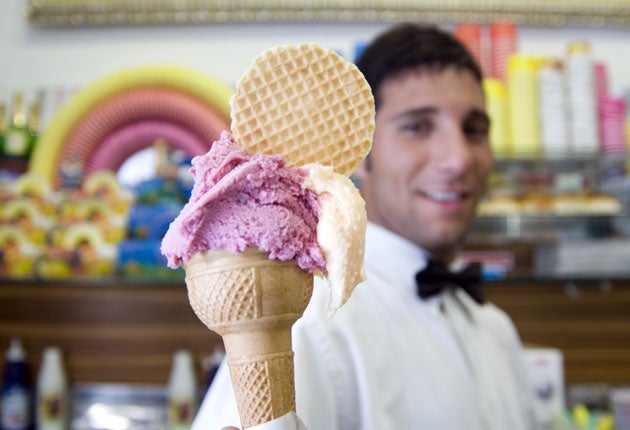Appetite for lower-fat ice cream feeds high-street 'gelato' boom

When is an ice cream not an ice cream? When it's a "gelato".
A new fashion for frozen desserts with lower fat content than traditional ice-cream has become a multi-million-pound industry in Britain, with new outlets springing up almost weekly. Over the past two years some 80 have opened across London. Antonio Federici Gelato Italiano, launched two years ago, is sold in Waitrose, Sainsbury's and Harrods and is now worth £5m. Its gelato academy opens in January.
In Italy, the word gelato is used interchangeably for both full-fat and lower-fat ice cream. In both Britain and the US there is no legal definition for the confection. Robin Weir, co-author of Ice Creams, Sorbets and Gelati: The Definitive Guide, said he had asked the US Food and Drug Administration the difference between gelato and ice cream. "I guess about 50 cents to $1 a scoop," an official said.
Weir said: "True gelato, which stems from Sicily and Naples, historically was made with milk – and either eggs or, later, cornflour. It didn't contain cream; the fat originally came from egg yolk. It is heavier and denser than ordinary ice cream, with a lower fat content and a stronger taste because fat masks flavour."
It was "an almighty muddle" and very hard to find "true gelato" in the UK, he said, but added that the Bocca di Lupa restaurant in London sold the real deal.
Matt O'Connor is creative director at Federici and founder of The Icecreamists, specialising in fresh gelato which, he says "contains 6-7 per cent fat, while American ice creams tend to contain between 12 and 16 per cent".
The gelaterias are not confined to London. At one of Britain's first. Morelli's, in Broadstairs, Kent – decorated in Formica, lino and vinyl from the late 1950s – manager Chris Chaokin said there had been a 100 per cent rise in gelato sales over the past two years. "Coffee bars are going out while gelaterias are coming in," he said.
Nardini's in Largs, on the west coast of Scotland, has experienced a similar rise in gelato sales, as has Boho Gelato, which opened last year in Brighton and counts sea-salted caramel and sour cherry among its most popular flavours.
Adriano Di Petrillo, who founded the Dri Dri gelaterias in London, said: "We are far from saturation of the gelateria market – in Sicily there is almost one gelateria for every 1,000 people."
Join our commenting forum
Join thought-provoking conversations, follow other Independent readers and see their replies
Comments